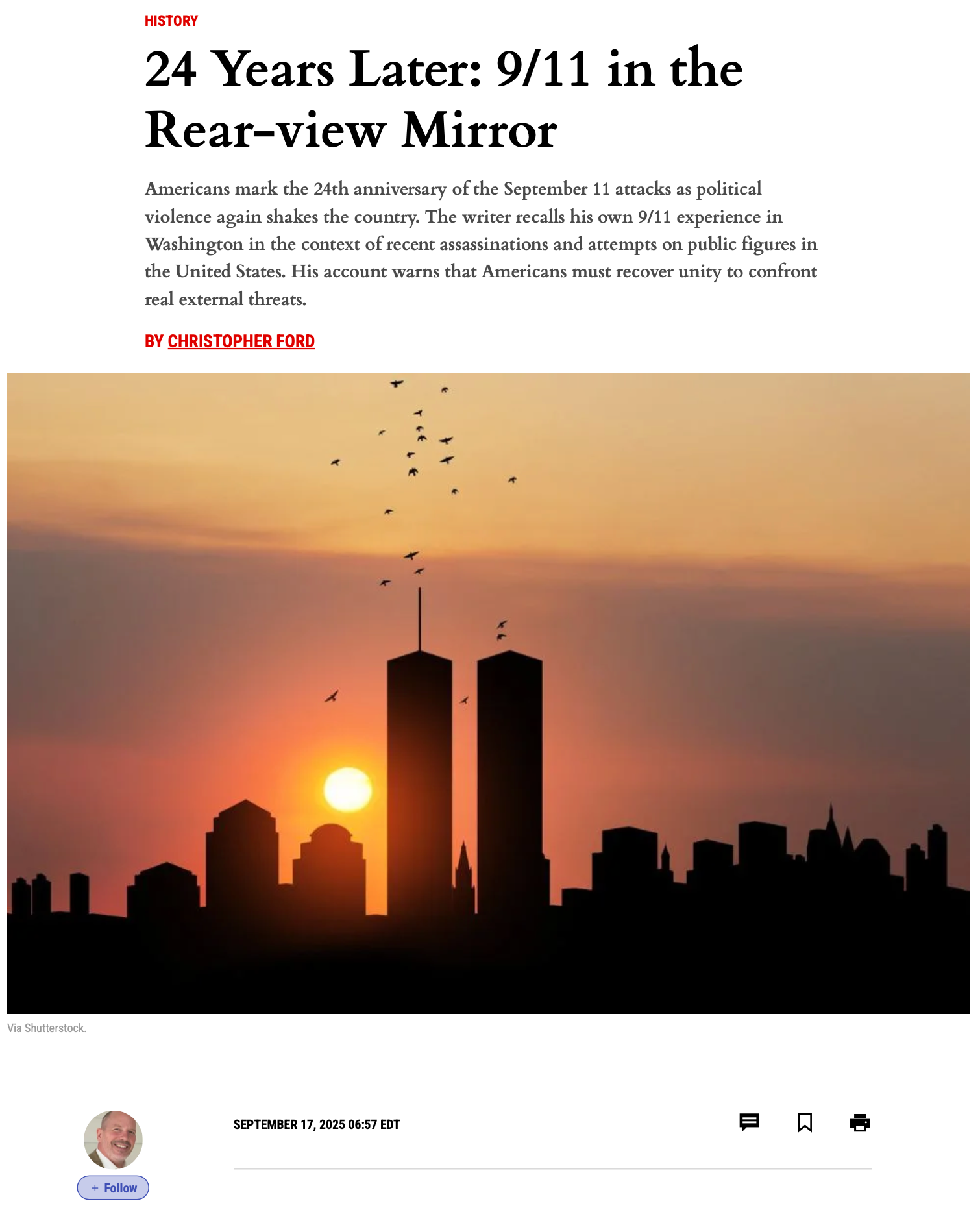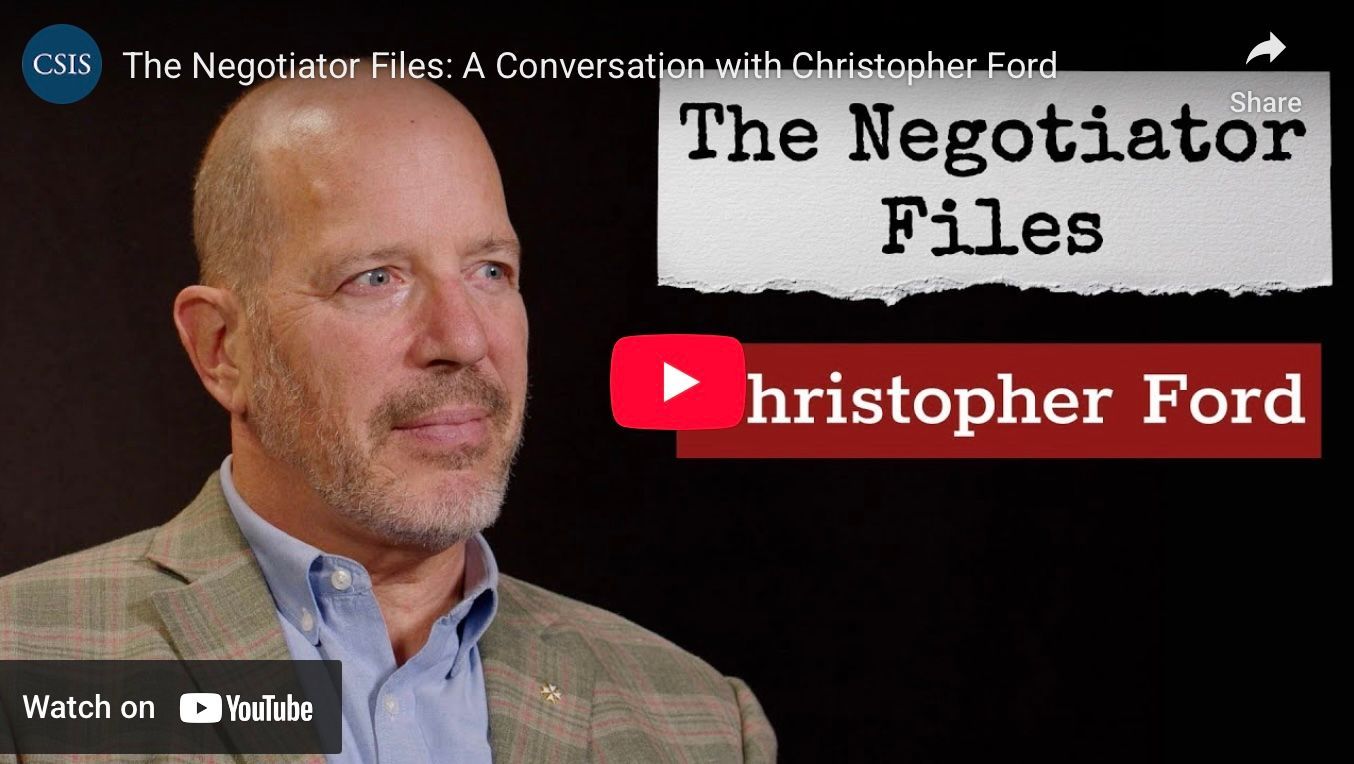Is “Weaponless Deterrence” Possible?
Note:
The following essay briefly summarizes a longer paper Dr. Ford prepared – the first results of a study generously supported by the Carnegie Corporation of New York – for a Hoover Institution conference on “ Nuclear Deterrence: Its Past and Future ” (November 11-12, 2010). Click here for the longer paper, which is now available from Hudson Institute .
In my longer paper which I merely summarize here – the first results of a study generously supported by the Carnegie Corporation of New York – I explore issues surrounding the concept of “countervailing reconstitution” (CR) of nuclear weapons (a.k.a. “weaponless deterrence” or “virtual nuclear arsenals”) as a potential tool to facilitate reductions in present-day nuclear arsenals and perhaps provide insurance against “breakout” from an abolition regime. My paper traces the idea of CR, beginning with its origins in the Acheson-Lilienthal Report of 1946, which conceived of a world in which host-government seizure of internationally-controlled nuclear facilities might be in some measure deterred by the likelihood that in such circumstances, other governments would also seize facilities located within their territories and use them to build countervailing arsenals. This idea had subsequent echoes during the Cold War in the writings of Herman Kahn on issues surrounding pre-attack mobilization, and then most notably in the work of Jonathan Schell, whose book The Abolition made a prominent and eloquent case for “weaponless deterrence.”
The conceptual insight behind CR is the notion that potential nuclear weapons – that is, a country’s ability to construct such devices – has at least some deterrent value, and that it may be possible for potential weapons to serve to some degree as a substitute for “weapons-in-being.” Among the scholars to have considered this issue, however, opinions vary as to how far this idea can be pushed.
The idea began to receive sustained attention in the 1990s, as a few studies began to emerge of how CR-type concepts might help facilitate reductions, such as by making a country more willing to accept cuts in the size of its nuclear arsenal because it has confidence in its ability to manufacture additional weapons if a grave new threat should emerge. Some scholars even began to explore the idea that CR could be pushed to the asymptote of nuclear weapons abolition , with other countries’ ability to begin or resume nuclear weapons work providing at least some insurance against – and deterrence of – any attempt by a would-be violator to achieve “breakout” from such a disarmament regime. By the 2000s, such thinking had emerged as an important theme of disarmament debates, with multiple U.S. administrations endorsing CR as a tool with which to facilitate arms reductions, and potentially even as a capability to be retained at some hypothetical future “zero.”
The main body of my paper explores some of the substantive issues raised by the notion of CR – which I break, for analytical purposes, into “Tier One” and “Tier Two” varietals. It has long been clear that living with at least some form of CR will probably be inescapable, insofar as under any realistic scenario, dual-use nuclear technology and fissile materials will remain in the world. As long as this is the case, at least some countries will possess at least some ability to bring nuclear weapons back into the world after the achievement of any abolition regime. This kind of derivative CR capability – that is, CR as the byproduct of one’s possession of dual-use technology and nuclear materials – is what I term “Tier Two” reconstitution. The paper, however, focuses principally upon “Tier One” CR, which is conceived as the deliberate maintenance of a nuclear weapons reconstitution capability as a sort of strategic “hedge” for coping with resurgent threats in a “zero” world. How should one evaluate the merits and demerits of such intentional reconstitution planning for a world free of nuclear weapons?
To help shed some light upon this, the paper discusses the principal “big picture” critique often made against “Tier One” CR: a crisis-stability argument closely related, as an analytical matter, to criticisms also offered against nuclear force “de-alerting.” (The issues presented by CR are quite similar to those raised by “de-alerting.” In fact, one might describe the latter as a subspecies of “Tier One” reconstitution. Alternatively, one might view CR as an extreme form of de-alerting.) Thomas Schelling, Herman Kahn, Kenneth Waltz, and others have suggested reasons to be concerned about the degree to which CR might make international relations prone to reconstitution “races” that would be very destabilizing in times of tension or conflict, and might even create nuclear use incentives for the “winner” of such a contest. These worries are explored in some detail in the paper, with a particular eye to such challenges as: the likelihood that a CR-based deterrent balance would elicit a new arms race in technologies and methodologies aimed at maximizing the speed of reconstitution; the importance (and difficulty) of ensuring CR survivability in the face of the proliferation it would engender of so-called “showstopper” targets the destruction of which could derail reconstitution; the danger of “wildfire proliferation” in the emergence of a multi-player nuclear standoff once any single player has decided to commence reconstitution; and questions about whether nuclear weapons development actually could be deterred by the prospect of “virtual” arsenals.
The relationship between reconstitution and defenses against ballistic missiles and other forms of nuclear weapon delivery is also important, albeit an ambiguous one. Defenses would likely be stabilizing in the hands of potential victims of nuclear threats by a violator engaged in “breakout,” for such defenses would give such victims more time in which to respond ( e.g. , arm themselves with nuclear weapons as a deterrent) before the malefactor could harm them with its new weaponry. Defenses in the possession of the treaty violator itself, however, might be correspondingly de stabilizing, as they might tend to reinforce the advantages of breakout by impeding responsive attack undertaken in the interests of compliance enforcement. At least one scholar has suggested a way out of this paradox by hypothesizing a defensive regime in which defense-possessing and enforcement-minded countries could combine missile forces to threaten a defense-possessing violator with an attack capable of overwhelming its defenses. The challenge of managing the offense-defense relationship in a CR context, however, is not trivial – and is acknowledged even by advocates of strong ballistic missile defenses.
The second main part of the paper then goes on to assume the value of “Tier One” CR as a way to provide insurance against “breakout” from a “zero” regime. It uses this assumption for the sake of argument, as a sort of gedanken experiment in order to explore the programmatic implications CR might have if taken seriously by a country such as the United States. What might the United States actually have to do in order to maintain a credible “Tier One” CR capability over time in an abolition environment?
It turns out that this is a very difficult question to answer, for CR requires first making difficult decisions about what one would wish to reconstitute and how many of such things ( e.g., warheads, or delivery systems) one would need. Without such guidelines, it is hard to plan for what must be retained, and different answers to these questions will result in very different infrastructural and human capital requirements. A reconstituted arsenal with “counterforce” capabilities capable of threatening hardened military targets, for instance, will likely impose more demanding CR requirements than a merely “countervalue” arsenal in which comparatively crude weapons are to be aimed at civilian populations. Similarly, reconstituting a Cold War-style “legacy” arsenal would probably be much more difficult than reconstituting an arsenal optimized for some set of presumed post-“zero” conditions, perhaps including warhead designs developed specifically with an eye to speed and ease of reassembly. Since no one has apparently yet engaged – or perhaps really knows how to engage – in serious force posture planning for a hypothetical “post-zero” world of reconstituted arsenals, all one can do at this point is speculate.
That said, the emerging field of what one might call “reconstitution theory” may help us identify particular challenges, and the programmatic later portions of my paper examine some of them – in part by offering lessons suggested by post-Cold War U.S. experiences with nuclear weapons complex shrinkage and consolidation. These American experiences suggest that considerable challenges would face “Tier One” CR planners attempting to preserve an effective weapons production infrastructure over many years in an abolition environment. U.S. experiences with plutonium “pit” production (for implosion-type nuclear weapons) and with the remanufacture of exotic non-nuclear materials needed for refurbishing the W-76 warhead in the early 2000s, for instance, suggest that it can be terribly difficult to re-learn specialized techniques and processes once they have been halted or abandoned. It can also be very difficult to maintain a sufficiently sharp and capable stock of human capital – that is, scientists, engineers, and technicians with the specialized skills necessary for weapons design, fabrication, and maintenance – over long periods of time in an industry that one intends to preserve, to some extent, merely in a deliberately moribund state.
The game-theoretical requirements of CR survivability, moreover, may impose additional challenges on reconstitution planning, particularly with regard to reducing the vulnerability of the constituent elements of one’s weapons infrastructure. Post-Cold War reforms of the U.S. weapons complex have to date focused largely upon shrinkage and consolidation, but CR survivability concerns might mean that “Tier One” CR planning would drive the process in the opposite direction – i.e. , toward redundancy and geographic distribution – lest consolidation make it dangerously easy for any attacker to cripple the reconstitution process by attacking its key procedural “choke points.” Uncertainties about how many reconstituted weapons one might actually want could also have a similar effect in eliciting a larger aggregate CR infrastructure, for lessons from U.S. consolidation efforts in the 1990s suggest the importance of sizing one’s future infrastructure on the basis more of high-end estimates of a potential future stockpile than low-end ones. (When one is merely guessing at future national security requirements, the price of error may be less if one retains unused surplus capacity than if one suddenly needs more weapons than it is physically possible for one’s infrastructure to produce.) Analogous challenges may arise with respect to the maintenance of specialized delivery systems capable of dispatching reconstituted warheads to their targets.
In order to ensure the indefinite upkeep of a credible “Tier One” CR capability, the requisite budgets, facilities, and human capital would also have to be maintained in the face of the considerable “out of sight/out of mind” problems that would confront an expensive and challenging CR program as it competed with other defense and budgetary priorities in a nuclear weapons-free world. This is a major concern of CR skeptics, who point to the considerable challenges the U.S. nuclear weapons complex has had since the end of the Cold War in maintaining itself in a robust and effective form. If we cannot do this even while thousands of nuclear warheads remain in our arsenal and we remain at least officially committed to a form of nuclear deterrence rooted in the upkeep of weapons-in-being, they ask, how could we expect to maintain such capabilities indefinitely in a world of “zero”? In particular, if democratic societies possessing reconstitutive capabilities are not to fall behind in their maintenance of “Tier One” CR, preventing such atrophy will be an ongoing challenge. (Dictatorships, one imagines, are likely to have an easier time maintaining commitment to CR.) Given the likely inescapability of a world of widespread CR capabilities at least at the “Tier Two” level, however, it may not be possible to avoid struggling with these issues, even if only to avoid additional asymmetry.
In its concluding comments, the paper discusses the possibility that CR may be to some degree a “self-solving” problem. Some of the thinkers who have explored CR issues wonder whether “virtual nuclear arsenals” can be squared with nuclear weapons abolition in a stable and sustainable way absent some very significant prior transformation of international politics – not necessarily a thoroughly utopian revolution in politico-cultural attitudes which will lead lions to lie down placidly with lambs, but at the very least a significant additional strengthening of trust and easing of tensions. For such observers, the stability problems of CR-based abolition might be said to solve themselves, in the sense that the very geopolitical conditions which would be required in order for even a CR-based “zero” to be possible in the first place would themselves rob those problems of much of their salience.
Others, however, disagree that the transformation of international politics is a precondition for a CR-based “zero.” Indeed, they contend that the whole point of “countervailing reconstitution” is that it offers the potential to achieve nuclear weapons abolition in a way that permits the continuation of the nuclear deterrence paradigm. CR aims to achieve “zero” without having magically to overcome millennia of distrust and power-political thinking in international relations. This question, however, remains very much alive in the expert literature.
My paper closes by arguing that whether or not one accepts the precondition of political transformation, and however one assesses the desirability and feasibility of a CR-based “zero,” there is clearly value in the notion of countervailing reconstitution at least as a means to facilitate further weapons reductions, at least for the moment. Potential weapons can substitute for weapons-in-being, and likely to a greater extent than they do at present. At the very least, a production-capable weapons infrastructure can help possessors reduce the perceived need to keep reserve stockpiles as a form of “strategic hedging,” and perhaps help ease any perceived deterrence costs of some reduction in other stocks. In a world in which very considerable numbers of nuclear weapons still exist, this is certainly not nothing.
-- Christopher Ford







